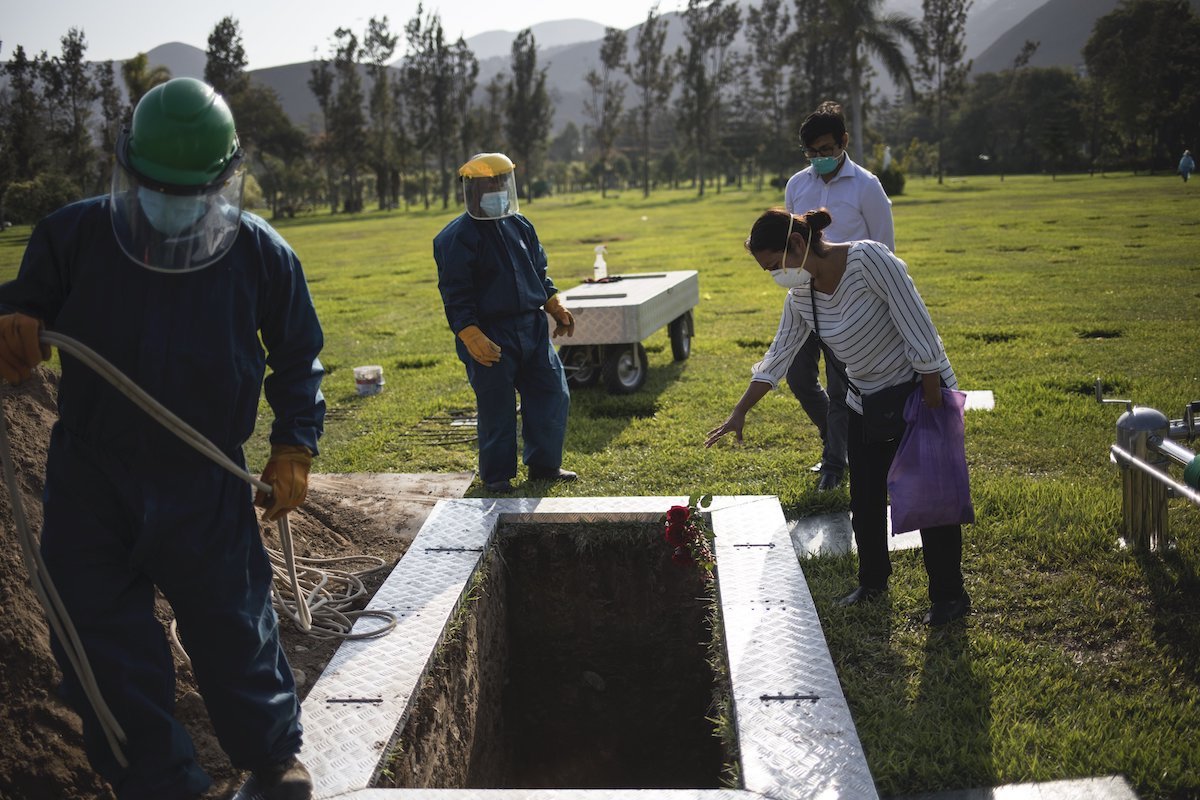

In this May 28, 2020 file photo, Marylin Bucana throws flowers on the coffin of her father Mario Bucana, a TV news cameraman who died of COVID-19, during his burial in Lima, Peru. (AP Photo/Rodrigo Abd, File)
By CHRISTOPHER TORCHIA, Associated Press
MEXICO CITY (AP) — Dozens of journalists have died from COVID-19 in Peru since the pandemic began, in the highest reported death toll of media workers from the new coronavirus in Latin America, according to journalists’ groups that are monitoring available data.
As in many countries, the new coronavirus has hit virtually all sectors of society and areas in Peru, killing and sickening medical workers, teachers, street vendors, the unemployed and others. But emerging data on fatalities among journalists in Peru is among the highest in the world, although it is extremely difficult to confirm in many cases whether they got sick after covering pandemic news or doing other work.
On Wednesday, a Catholic priest held a virtual Mass at a church for 22 journalists —19 men and three women— that the College of Journalists of Lima said had died in the Lima area alone. Ricardo Burgos Rojas, the college dean, said many were freelancers and some worked for Panamericana Television, TV Peru, Agencia de Noticias Andina, Radio Exitosa and other outlets.
“What’s happening with the journalists in Peru is somewhat a reflection of what’s happening with the Peruvian population,” said Zuliana Lainez, secretary general of the National Association of Journalists of Peru, a union based in Lima.
At least 82 reporters in Peru died from the disease between March 16, when Peru imposed a lockdown because of the health crisis, and Aug. 17, according to the association. Many were more than 65 years old, and several of those listed were retired.
“In May the [Amazon] jungle and the north of the country had the biggest number of victims, now it’s the south of the country,” Lainez said. In many cases, she said, reporters did not have adequate protective equipment while attending news conferences or traveling to assignments, and felt compelled to work because they needed the money.
Lainez said the data was based on information from nationwide affiliates, including coronavirus test results, medical reports and interviews with family members. The association estimates that more than half of those who died had not contracted the virus because of their work as journalists, based on their movements, illness within their families and other factors.
Like other countries, Peru has struggled to obtain data and reconcile discrepancies over COVID-19. Doctors have sometimes attributed a death to the disease based on symptoms, rather than a test result. There are questions about the accuracy of death certificates. Especially in the early days of the pandemic, there was a stigma attached to a coronavirus-related death.
The Peruvian toll is more than double the reported 40 deaths of journalists in neighboring Ecuador, and a total of 171 journalists in Latin America are reported to have died from the disease, according to the regional office of the International Federation of Journalists. However, the non-profit Fundamedios group said August 11 that the death toll in Ecuador was 20.
On August 7, the Inter American Press Association paid tribute to more than 100 media workers in the Americas who had died from COVID-19 “in the exercise of their profession,” listing names of the deceased but not providing details about how they may have contracted the virus.
The Press Emblem Campaign, a Geneva-based group launched by journalists, said July 1 that Peru had lost the most journalists to COVID-19 of any country in the world.
The Committee to Protect Journalists does not have a database of journalists who have contracted COVID-19. The New York-based group said media workers “are often potentially exposed to infection through travel, interviews, and the locations they find themselves working in,” and recommends the use of protective equipment, as well as hygiene and social distancing measures, to reduce the chance of infection in the field.
CPJ said it has documented several cases of journalists who died or were suspected to have died of COVID-19 after they were jailed because of their work, including in Egypt, Honduras and Kyrgyzstan.
Peru, with a population of 33 million, has reported more than 26,800 COVID-19 deaths, though the real number is believed to be much higher because of difficulties in confirming the cause of many fatalities. It has logged 560,000 coronavirus cases, placing it in the top 10 countries —half of them in Latin America— with the most confirmed cases in the world.
Freelancer Ricardo Gutiérrez Aparicio was among the first Peruvian journalists reported to have died of COVID-19. The College of Journalists of Lima announced his death on April 1.
Peruvian journalist César Campos tweeted two days later that, with the death of his friend, “The virus and its tragic consequences are knocking on our door.”



[…] Christopher Torchia, Associated Press: Pandemic’s Toll Among Journalists in Peru Is Especially High […]